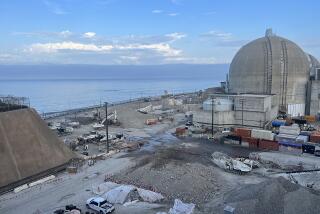Stanford Shuts Down Its Atom Smasher
A radically new type of atom smasher that has been giving nightmares to its creators at Stanford University has been shut down temporarily so that major modifications can be completed.
The $115-million Stanford Linear Collider, designed to hurl electrons and positrons into each other at nearly the speed of light, will be out of service until at least the end of October, according to Michael Riordan, a physicist and spokesman for the collider project.
The collider is more than a year behind schedule because its unconventional design has proven more challenging than scientists had expected. It had been hoped that the collider--which uses a 2-mile-long linear accelerator that is 20 years old--would be able to produce subatomic particles at a fraction of the cost of colliders of conventional design by firing the particles into two opposing arcs and bringing them together at a collision point. But there have been many problems with the Stanford facility.
It now appears likely that a competing collider--built at about 10 times the cost of the Stanford facility and of a conventional, circular design--will beat Stanford to the punch when it starts operating near Geneva sometime next year. Both facilities are designed to produce âZâ particles, which are believed to be the bearers of the âweakâ force that allows some elements to decay into other forms, a process that sometimes releases radioactivity.
Only a few dozen âZâ particles have been captured, all of them in Europe, and scientists at Stanford had hoped to produce tens of thousands by the time the new European facility comes on line. âZâ particles survive only momentarily in the debris of violent collisions of electrons, which are negatively charged, and positrons, which are positively charged.
After months of frustration, Stanford officials concluded earlier this summer that they would have to make major modifications in their collider if it is ever to work for long enough periods to produce the elusive particles in significant numbers.
Monday morning at 6 a.m., Nobel laureate Burton Richter, director of the Stanford Linear Accelerator Center, led a team down to the collider and officially shut it off.
âWeâre shutting it down for repairs,â Riordan said. âWhat we are trying to do is make some of the improvements that are needed up and down the machine, and we canât do that without shutting it down.â Riordan said that the modifications are expected to cost âin the millions of dollars.â
Scientists hope to increase the intensity of the beams of electrons and positrons, packing more particles into the beams that are to collide inside a giant detector where the event will be recorded, Riordan said. Unless the âpacketsâ of electrons and positrons are tightly packed, the beams will pass through each other without any collisions.
As they have struggled over the last few months to make their machine work, scientists at Stanford have been bedeviled by subatomic particles called âmuonsâ that are created when the beams brush against the sides of the pipe in which they travel. Muons clutter the background, making it far more difficult for physicists to separate the particles they are seeking from the junk that surrounds them.
Giant Magnets
To solve that problem, giant magnets weighing many tons will be placed inside the collider to deflect the muons away from the sensitive detectors that tell the story of the collisions.
âThese are big, bulky, heavy devices,â Riordan said. âIt will take time to move them in there.â
While the repairs are being made to the collider, the 2-mile-long race track through which the electrons and positrons are accelerated will continue operating in support of other experiments at the center. For the last two years, most other projects have been shelved while work proceeded on the collider.






